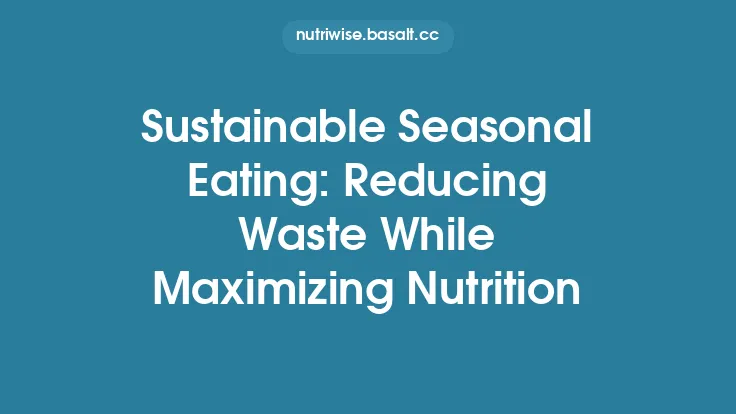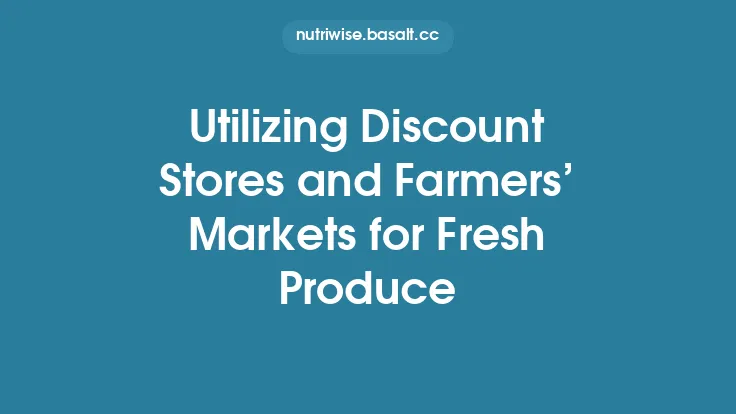When it comes to feeding a household on a realistic budget, the checkout aisle often holds more power than the dinner table. By mastering the twin strategies of bulk buying and seasonal purchasing, shoppers can dramatically lower their grocery bills while still enjoying fresh, high‑quality ingredients. This approach isn’t about buying more than you need; it’s about buying smarter—leveraging price structures, storage science, and the natural rhythms of the food supply chain. Below, we break down the mechanics, the math, and the methods that turn everyday grocery trips into long‑term savings.
Understanding Unit Pricing: The Foundation of Smart Buying
Every product on a shelf carries a hidden metric: the cost per unit of weight, volume, or count. Supermarkets display this information in the fine print (e.g., $2.99 per 16 oz). To compare a 12‑oz bag of rice with a 5‑lb bulk sack, convert both to the same unit (price per pound, per ounce, or per gram).
- Formula:
\[
\text{Unit Price} = \frac{\text{Total Price}}{\text{Quantity (in consistent units)}}
\]
- Practical tip: Use a calculator app or a simple spreadsheet column to log the unit price of staple items each week. Over time, you’ll spot which brands truly offer a discount and which rely on “big‑size” packaging to appear cheaper.
When and How to Buy in Bulk
Bulk buying shines for items that have a long shelf life, stable flavor, and low risk of spoilage. Below is a quick reference guide:
| Category | Ideal Bulk Form | Typical Shelf Life | Storage Tips |
|---|---|---|---|
| Grains (rice, quinoa, oats) | Sealed poly‑bags or airtight containers | 12–24 months | Store in a cool, dry pantry; add a food‑grade desiccant packet |
| Legumes (beans, lentils) | Bulk bins or large resealable bags | 2–3 years | Keep in airtight containers; rotate stock front‑to‑back |
| Nuts & Seeds | Vacuum‑sealed packs | 6–12 months (refrigerated) | Freeze after opening to extend freshness |
| Cooking Oils | Large bottles (e.g., 2 L) | 12 months (dark glass) | Keep away from light; transfer to amber glass for daily use |
| Spices & Herbs | Bulk jars or tins | 2–4 years (ground) | Store in a dark cabinet; avoid moisture |
| Frozen Vegetables & Fruit | Family‑size bags | 8–12 months | Keep freezer at –18 °C (0 °F) or lower; avoid frequent temperature swings |
Key considerations before bulk‑purchasing:
- Consumption Rate: Estimate how much you actually use in a month. If you only need 1 lb of almonds per month, a 5‑lb bag may become a costly waste.
- Storage Capacity: Ensure you have space that maintains the recommended temperature and humidity. Overcrowding a pantry can trap moisture, leading to mold.
- Packaging Integrity: Look for resealable, puncture‑resistant packaging. If the original bulk bag is flimsy, transfer the contents to a sturdier container immediately.
Seasonal Produce: Timing Your Purchases
Produce follows a natural calendar dictated by climate zones and harvest cycles. Buying fruits and vegetables at the height of their season yields three major benefits:
- Lower Prices: Supply peaks, demand stabilizes, and retailers slash prices.
- Superior Flavor & Nutrition: Plants harvested at peak ripeness retain more sugars, vitamins, and antioxidants.
- Reduced Carbon Footprint: Shorter transportation distances mean less fuel consumption.
How to identify seasonal windows without relying on farmers’ markets:
- National Agricultural Reports: USDA’s “Seasonal Produce Guide” (available online) lists peak months for each commodity.
- Supermarket Seasonal Signage: Many chains label “In‑Season” produce near the display.
- Online Price Trackers: Websites like “PriceWatch” aggregate weekly grocery flyer data, allowing you to spot price dips for specific items.
Strategic buying patterns:
- Stock Up on Storable Seasonal Items: Root vegetables (carrots, potatoes, beets) and hardy greens (kale, collards) can be stored for months in a cool, dark cellar or refrigerator crisper.
- Buy Fresh, Then Preserve: Purchase a surplus of berries or tomatoes when they’re cheap, then freeze, can, or dry them for off‑season use (see the next section).
- Leverage “Peak‑Season Sales” Cycles: Many retailers run “summer produce” or “winter root veg” promotions. Align your weekly shopping list with these cycles.
Storage Solutions for Bulk Items
Proper storage is the linchpin that turns bulk buying into genuine savings. Below are science‑backed methods for the most common bulk categories.
1. Airtight Containers & Vacuum Sealing
Oxygen and moisture are the primary culprits behind spoilage. Using containers with a CO₂ barrier (e.g., PETE or high‑density polyethylene) or a vacuum sealer dramatically slows oxidation. For grains and legumes, a simple Mylar bag with an oxygen absorber can extend shelf life to 10 years under ideal conditions.
2. Temperature Control
- Pantry (15–21 °C / 60–70 °F): Ideal for dry goods like rice, pasta, and canned foods.
- Refrigerator (1–4 °C / 34–40 °F): Best for nuts, seeds, and opened butter or cheese.
- Freezer (–18 °C / 0 °F): Use for bulk meat, fish, bread, and pre‑blanched vegetables.
3. Humidity Management
A silica gel packet or a small desiccant placed in the container can absorb excess moisture, preventing clumping in flour or mold in dried herbs.
4. Rotation System (FIFO)
Label each container with the purchase date. Place newer items behind older ones, ensuring you consume the oldest stock first. A simple “first‑in, first‑out” system eliminates waste.
Preserving Seasonal Harvests
When a fruit or vegetable is at its cheapest, the logical next step is to extend its usability. Below are three low‑tech, high‑yield preservation methods that complement bulk buying.
Freezing
- Blanching: Briefly boil vegetables (2–4 minutes) then shock in ice water. This deactivates enzymes that cause color and texture loss.
- Packaging: Use freezer‑grade zip‑lock bags, squeeze out air, and label with the date and type.
Canning
- Water‑Bath Method: Suitable for high‑acid foods (tomatoes, peaches). Follow USDA guidelines for processing times to ensure safety.
- Pressure Canning: Required for low‑acid foods (beans, corn). Invest in a reliable pressure canner and a calibrated pressure gauge.
Dehydrating
- Oven or Food Dehydrator: Slice produce uniformly (≈¼ inch) for even drying. Store dried pieces in airtight containers with a desiccant.
- Rehydration Ratio: Typically, 1 cup dried fruit rehydrates to about 2–3 cups fresh, useful for planning future meals.
Cost‑Benefit Analysis: Bulk vs. Small Packages
A quick spreadsheet can reveal the true economics of bulk purchases. Here’s a step‑by‑step template:
| Item | Small Pack Price | Small Pack Size | Small Pack Unit Cost | Bulk Pack Price | Bulk Pack Size | Bulk Unit Cost | Savings % |
|---|---|---|---|---|---|---|---|
| Olive Oil | $6.99 | 500 ml | $13.98/ L | $12.49 | 2 L | $6.24/ L | 55% |
| Brown Rice | $2.49 | 1 lb | $2.49/ lb | $8.99 | 10 lb | $0.90/ lb | 64% |
Interpretation: Even after accounting for potential waste, the bulk option often yields a net saving of 40–70 %. However, if the bulk item expires before use, the effective cost rises dramatically. Hence, the spreadsheet should also factor in an estimated “waste multiplier” (e.g., 0.1 for 10 % expected loss).
Smart Shopping Tools and Apps
Technology can automate much of the price‑tracking and inventory management:
- Unit Price Scanners: Apps like “ShopSavvy” or “Flipp” let you scan barcodes and instantly compare unit prices across brands.
- Grocery List Managers: “AnyList” or “Out of Milk” allow you to tag items as “bulk” or “seasonal,” and they sync across family members.
- Price History Trackers: Websites such as “CamelCamelCamel” (for online grocery retailers) show historical price trends, helping you decide the optimal purchase window.
- Pantry Inventory Apps: “Pantry Check” lets you log bulk items, set expiration alerts, and generate shopping suggestions based on what you already have.
Avoiding Common Pitfalls
Even seasoned shoppers can fall into traps that erode savings:
- Impulse Bulk Purchases: The “big‑size discount” can be alluring, but if the product isn’t on your regular rotation, you’ll likely waste it.
- Ignoring Shelf Life: Some bulk items (e.g., whole grain flours) have a shorter usable window once opened. Transfer to airtight containers and use within 3–6 months.
- Over‑Freezing: Freezer burn occurs when air contacts food. Vacuum sealing or using freezer‑grade bags eliminates this issue.
- Neglecting Price Per Unit: Promotional “buy one, get one free” offers can be misleading if the unit price is higher than a regular‑size product.
- Skipping the “Seasonal” Check: Buying out‑of‑season produce often means paying a premium for imported goods that have traveled thousands of miles.
Community Strategies for Bulk Buying
If your household cannot consume a full bulk package, consider collaborative approaches:
- Co‑op Purchasing: Form a small group of neighbors to split a 25‑lb bag of beans. Each member contributes a portion of the cost and takes home a sealed sub‑bag.
- Bulk‑Buy Clubs at Local Stores: Some grocery chains allow customers to reserve bulk bins for a set fee, guaranteeing availability without over‑stocking.
- Shared Freezer Space: Arrange a “freezer swap” where families rotate bulk‑frozen items they don’t need, reducing individual waste.
These community models not only stretch dollars but also foster a culture of resourcefulness.
Putting It All Together: A Practical Shopping Workflow
- Pre‑Shop Planning (Weekly)
- Review pantry inventory in your app; note items nearing expiration.
- Check seasonal produce calendars and price‑tracking tools for upcoming sales.
- Create a Tiered List
- Tier 1: Bulk staples needed (e.g., rice, beans, nuts).
- Tier 2: Seasonal produce on sale.
- Tier 3: Perishables for immediate consumption.
- In‑Store Execution
- Scan each item’s barcode; verify unit price before placing in cart.
- For bulk bins, weigh the exact amount you need, then transfer to a pre‑labeled container.
- Immediately place perishable bulk items into a cooler bag to maintain temperature.
- Post‑Shop Processing
- Transfer all bulk purchases to their designated storage containers.
- Label with purchase date, best‑by date, and any preservation instructions.
- Update your pantry app with new stock levels.
- Monthly Review
- Run the cost‑benefit spreadsheet to confirm expected savings.
- Adjust future bulk purchases based on consumption trends and any waste observed.
By following this systematic approach, you turn grocery shopping from a reactive chore into a proactive, data‑driven habit that consistently trims expenses while keeping your kitchen stocked with high‑quality, fresh ingredients.





